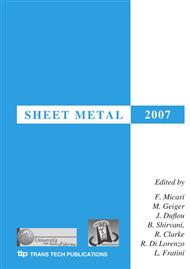p.807
p.817
p.825
p.833
p.841
p.847
p.855
p.865
p.873
An Intelligent Tool to Predict Fracture in Sheet Metal Forming Operations
Abstract:
One of the main issues in sheet metal forming operations design is the determination of formability limits in order to prevent necking and fracture. In fact, the ability to predict fracture represents a powerful tool to improve the production quality in mechanical industry. Many researchers investigated the problem here addressed, mainly studying forming limit diagrams (FLD) or developing fracture criteria which are able to foresee fracture defects for different processes. In this paper, the author present some early results of a research project focused on the application of artificial intelligence (AI) for ductile fracture prediction in sheet metal forming operations. The main advantage of the application of AI tools and in particular, of artificial neural networks (ANN), is the possibility to obtain a predictive tool with a wide applicability. The prediction results obtained in this paper fully demonstrate the usefulness of the proposed approach.
Info:
Periodical:
Pages:
841-846
Citation:
Online since:
July 2007
Authors:
Keywords:
Price:
Сopyright:
© 2007 Trans Tech Publications Ltd. All Rights Reserved
Share:
Citation:


